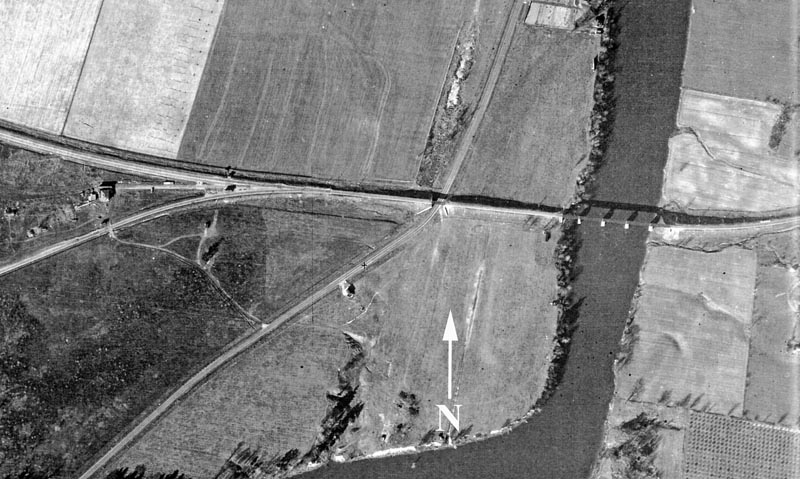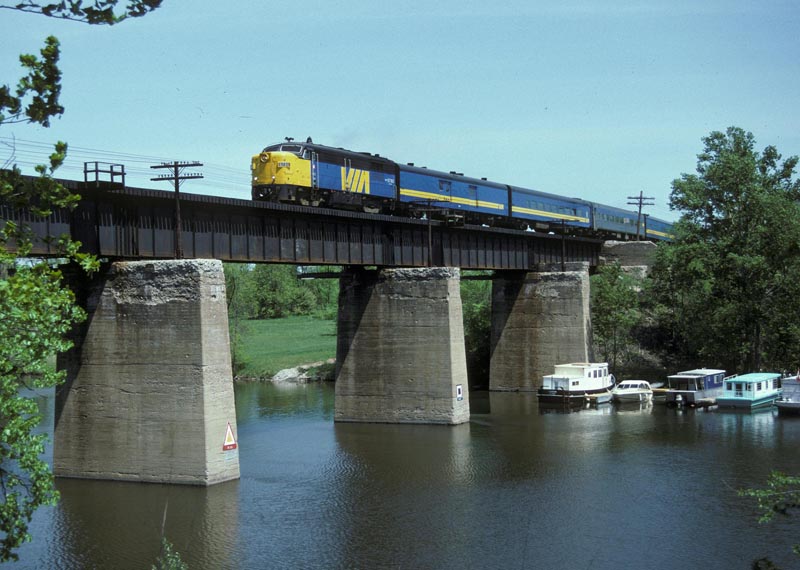
Travelling by train from The Canadian Northern Ontario Railway,
which became part of
the Canadian Northern in May1914, was the last main line railway to
enter - - Construction of the line
westwards out of A reporter from the Ottawa Journal visited the work and wrote on 6 July 1912: “Spanning
the “The
cement piers, four in number, are already finished, also the abutments
on the
eastern side. “All that
remains to be done at present, to allow the wooden trestle work to be
started
is topping off the western abutment with about four feet of cement,
which will
be finished in the course of the coming
week. “Each pier is fifty feet in height from the bottom of the
foundation,
about ten feet below the surface at low water. “No
difficulties or delays were experienced throughout the operation save
with pier
No. 4 on the western side, and here it was due to the erroneous
soundings of
those who went before. Marked in the
plan as rock foundation, the base of pier No. 4 was to measure 16 feet
by 36
feet, but when actual work was begun, quicksand formation was
discovered
necessitating the enlargement of the base to 20 feet by 40 feet. “A drill
was sunk in the middle of the proposed base in the primary stages of
erection
and on being drawn out water followed it as in an artesian well. One hundred and twenty-eight piles were
driven for support and the work since has been speedily carried on. Between 12,000 and 15,000 bags of cement have
been used in the cement work of abutments and piers. “There
will be five spans in the new bridge. From
either abutment to the nearest pier the span will be
76 feet 6
inches, and three central spans of 100 feet 4 inches.
“The
graded embankment on the east side running through the Dowler Farm is
being
rushed so that the laying of tracks will be possible with the
completion of the
bridges, which will be by the first of September. “Double
tracking will be placed on the new bridge and the road from “Construction
of the cement work was under the able superintendency of Mr. Charles
Johnston.” The bridge piers were constructed for a double track, indeed provision was made for double track for the entire line to Ottawa Central Station but a single line was only ever laid down. The
Ottawa Journal of 3
October 1912 reported “The new
big steel bridge over the Rideau is now practically completed which,
with the
bridge over the Jock River already completed, leaves the section from
Ottawa to Smiths Falls ready for the
putting
down
of the rails.”  Although
work on the bridge
proceeded smoothly there were some bureaucratic complications. The plans for the bridge were approved by
Order in Council (1911-805) on April 20 1911 and then by the Board of
Railway
Commissioners (order 13668) on 15 May 1911. The
order in council “approved
the plan submitted by the Canadian Northern Ontario Railway showing a
bridge
proposed to be erected over the Rideau River above Hogs Back Lock
Station on
the Rideau Canal, at mile 4.37 west from Ottawa, such bridge being 452'
in
length, composed of three one hundred foot and two seventy five foot
deck
girders, the bottom of the deepest girders being 31 feet above high
water
mark. The crown owns no land on either
bank of the Canal at this point.” It
also “grants, by way of
a lease, of the right or easement of constructing and maintaining the
proposed
structure; such lease to be at a rental of $1.00 per annum for a term
of 21
years renewable at the option of the Company for two further terms of
21 years
each.” Trouble began when the department of Highways and Canals forwarded a draft lease to the railway on 20 April 1911. G.C. Ruel, General Counsel replied on 13 June indicating that the CNOR took exception to lease. He pointed out that the Department did not own any land at the point of crossing and that the railway did not touch any of the lands owned by the Department. The river may be called a canalized river but there was nothing in the act compelling them to take out a lease for the privilege of crossing a canalized river. In reply, the Department of Justice pointed out that approval of the Governor-in-Council may be on terms as the Governor-in-Council may determine. The department followed up in early January 1912 insisting upon the lease being executed as drawn up. The railway ignored this until, in January 1913, the Department of Justice instructed their agent to take such proceedings as might be necessary to compel the company to remove its bridge or to come under the lease. However, it was acknowledged that the necessity for the lease was important only as a record. There was a delay of almost a year until on 5 January 1914 Ruel replied that while not agreeing with the attitude taken, it was not worth discussing further. They asked that the lease be modified for them to make payments for 10 years instead of making annual payments of $1. It was now the turn of the Department of Railways and Canals to drag its feet. It replied to Ruel on 22 December 1914 that the department was willing to accept an annual payment of $1.00 in advance for 10 years. Ruel finally returned the lease duly executed on 6 January 1915. The lease was renewed by Order in
Council PC 1932-932 of 26
April 1932 for a further period of 21 years at $1 per year and finally
by PC
1953-1053 of 2 July 1953. A final Order
in Council (PC 1975-2741) of 25 November 1975 approved an agreement
whereby the
railway was given permission to maintain the bridge over the Thus the storm in a teacup was
finally settled and
the bridge is now safe from bureaucratic interference.
Passengers traveling to  Picture
by Raymond Farand
[1] Much of the
detail for this article has been taken from Library and Archives Canada
RG 12
vol. 3710 file 4606-85-71. |
![]()